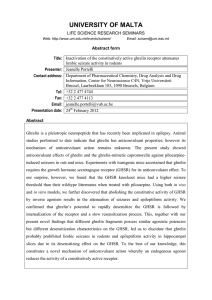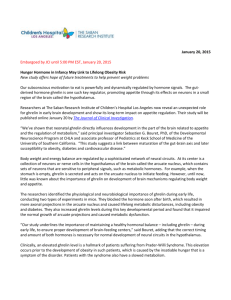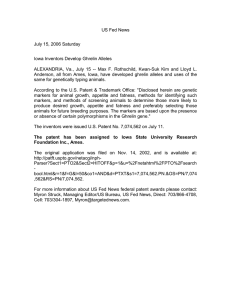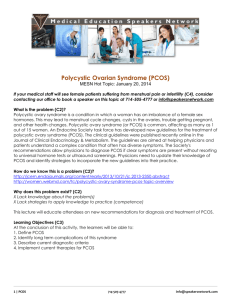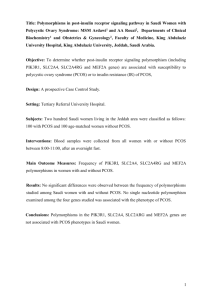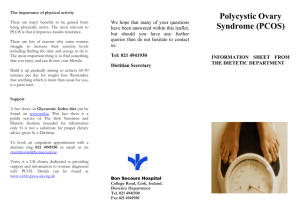Asian Journal of Medical Sciences 3(5): 218-222, 2011 ISSN: 2040-8773
advertisement
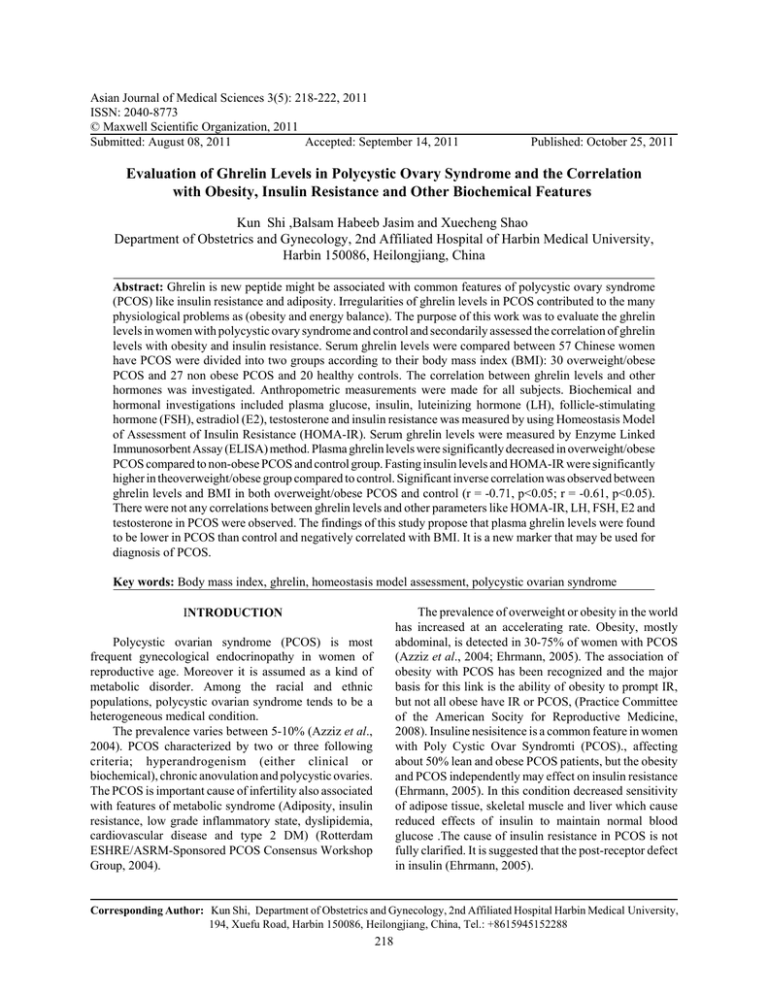
Asian Journal of Medical Sciences 3(5): 218-222, 2011 ISSN: 2040-8773 © Maxwell Scientific Organization, 2011 Submitted: August 08, 2011 Accepted: September 14, 2011 Published: October 25, 2011 Evaluation of Ghrelin Levels in Polycystic Ovary Syndrome and the Correlation with Obesity, Insulin Resistance and Other Biochemical Features Kun Shi ,Balsam Habeeb Jasim and Xuecheng Shao Department of Obstetrics and Gynecology, 2nd Affiliated Hospital of Harbin Medical University, Harbin 150086, Heilongjiang, China Abstract: Ghrelin is new peptide might be associated with common features of polycystic ovary syndrome (PCOS) like insulin resistance and adiposity. Irregularities of ghrelin levels in PCOS contributed to the many physiological problems as (obesity and energy balance). The purpose of this work was to evaluate the ghrelin levels in women with polycystic ovary syndrome and control and secondarily assessed the correlation of ghrelin levels with obesity and insulin resistance. Serum ghrelin levels were compared between 57 Chinese women have PCOS were divided into two groups according to their body mass index (BMI): 30 overweight/obese PCOS and 27 non obese PCOS and 20 healthy controls. The correlation between ghrelin levels and other hormones was investigated. Anthropometric measurements were made for all subjects. Biochemical and hormonal investigations included plasma glucose, insulin, luteinizing hormone (LH), follicle-stimulating hormone (FSH), estradiol (E2), testosterone and insulin resistance was measured by using Homeostasis Model of Assessment of Insulin Resistance (HOMA-IR). Serum ghrelin levels were measured by Enzyme Linked Immunosorbent Assay (ELISA) method. Plasma ghrelin levels were significantly decreased in overweight/obese PCOS compared to non-obese PCOS and control group. Fasting insulin levels and HOMA-IR were significantly higher in theoverweight/obese group compared to control. Significant inverse correlation was observed between ghrelin levels and BMI in both overweight/obese PCOS and control (r = -0.71, p<0.05; r = -0.61, p<0.05). There were not any correlations between ghrelin levels and other parameters like HOMA-IR, LH, FSH, E2 and testosterone in PCOS were observed. The findings of this study propose that plasma ghrelin levels were found to be lower in PCOS than control and negatively correlated with BMI. It is a new marker that may be used for diagnosis of PCOS. Key words: Body mass index, ghrelin, homeostasis model assessment, polycystic ovarian syndrome The prevalence of overweight or obesity in the world has increased at an accelerating rate. Obesity, mostly abdominal, is detected in 30-75% of women with PCOS (Azziz et al., 2004; Ehrmann, 2005). The association of obesity with PCOS has been recognized and the major basis for this link is the ability of obesity to prompt IR, but not all obese have IR or PCOS, (Practice Committee of the American Socity for Reproductive Medicine, 2008). Insuline nesisitence is a common feature in women with Poly Cystic Ovar Syndromti (PCOS)., affecting about 50% lean and obese PCOS patients, but the obesity and PCOS independently may effect on insulin resistance (Ehrmann, 2005). In this condition decreased sensitivity of adipose tissue, skeletal muscle and liver which cause reduced effects of insulin to maintain normal blood glucose .The cause of insulin resistance in PCOS is not fully clarified. It is suggested that the post-receptor defect in insulin (Ehrmann, 2005). INTRODUCTION Polycystic ovarian syndrome (PCOS) is most frequent gynecological endocrinopathy in women of reproductive age. Moreover it is assumed as a kind of metabolic disorder. Among the racial and ethnic populations, polycystic ovarian syndrome tends to be a heterogeneous medical condition. The prevalence varies between 5-10% (Azziz et al., 2004). PCOS characterized by two or three following criteria; hyperandrogenism (either clinical or biochemical), chronic anovulation and polycystic ovaries. The PCOS is important cause of infertility also associated with features of metabolic syndrome (Adiposity, insulin resistance, low grade inflammatory state, dyslipidemia, cardiovascular disease and type 2 DM) (Rotterdam ESHRE/ASRM-Sponsored PCOS Consensus Workshop Group, 2004). Corresponding Author: Kun Shi, Department of Obstetrics and Gynecology, 2nd Affiliated Hospital Harbin Medical University, 194, Xuefu Road, Harbin 150086, Heilongjiang, China, Tel.: +8615945152288 218 Asian J. Med. Sci., 3(5): 218-222, 2011 of height in meters). Overweight/Obesity was defined as BMI more than 25 kg/m2. Thirty overweight/obese and twenty seven non obese PCOS. Medical history and physical examination screened all the cases. None of them had any chronic disease or was undergoing any pharmacological treatment. All diabetics or those having glucose intolerance were excluded. Bodyweight and height were measured. The homeostasis model for the assessment of insulin resistance (HOMA-IR) defined insulin resistance. Ghrelin is synthesized mainly by endocrine cells in the gastric mucosa and it is a 28 amino-residue peptide. Ghrelin has been revealed to be a potent stimulant of Growth Hormone (GH) secretion from the pituitary. In addition it is appears to play an important role in the regulation of food intake and energy balance. Ghrelin and its receptors are expressed in pancreatic beta cells, proposing that it might have effects on insulin secretion (Sakata and Sakai, 2010). Ghrelin is secreted mostly from the stomach that activates appetite initiation in humans in starving conditions and drops postprandial, suggesting a relation between the ghrelin secretion and meal consumption. While insulin plays a vital role in the regulation and control of glucose (Cummings et al., 2001; Cummings and Shannon, 2003; Cicek and Inanc, 2011). Several studies exposed high levels of ghrelin during fasting, which returned to basal levels after meal ingestion (Asakawa et al., 2001; Toshinai et al., 2001; Tschop et al., 2000). Several works demonstrated that the ghrelin levels are lower in obese subjects (Ukkola and Poykko, 2002), however the plasma ghrelin levels rise increasingly in lean subjects during fasting and fall after eating. This declaration in previous studies sustains the possibility that ghrelin maybe performing as a ‘‘trigger’’ for meal initiation (Toshinai et al., 2001), as well as (Ukkola et al., 2002) suggested that the ghrelin might play a role in the pathogenesis of human obesity. On the other hand some researchers evaluated the relationship of ghrelin with gestational age (Imam et al., 2009). In PCOS, low levels of ghrelin were observed in PCOS compared to those in control groups (Glintborg et al., 2006; Micic et al., 2007; Moran et al., 2007) however not in all studies (Daghestani et al., 2011; Orio et al., 2003; Wasko et al., 2004). Moreover, plasma ghrelin is lower in Pima Indians, a population susceptible to obesity, compared with age and weight-matched Caucasians (Tschop et al., 2001). It is unclear from these studies whether ghrelin homeostasis is impaired in PCOS. The objectives of this study were to investigate ghrelin levels in Chinese women with or without PCOS and the relationship of these levels to the insulin resistance, obesity markers and other biochemical features of PCOS. Biochemical measurements: Subjects fasted overnight for 12 h, next morning fasting blood collected 5 mL, put it aside for 1 h, on the 3000 r/min. All blood samples for each woman were immediately centrifuged, and the serum was stored at -20ºC until analysis. The Fasting Serum Insulin (FIN) and Fasting Plasma Glucose (FPG) were estimated using the automated chemiluminescence analyzer. The basal serum levels of LH, FSH, E2, and testesterone were estimated using the: C C C C C C C E-test (TOSOH) II insulin (IRI) immune reagents TOSOH AIA Co., Ltd. Japan E-test (TOSOH) II testosterone (T) immunological reagents TOSOH AIA Co., Ltd. Japan E-test (TOSOH) II follicle stimulating hormone (FSH) immuno reactivity reagents TOSOH AIA Co., Ltd. Japan E-test (TOSOH) II luteinizing hormone (LH) immuno reactive reagents TOSOH AIA Co.,Ltd.Japan Glucose kit (enzymatic oxidation) Biological Engineering Co., Ltd. Shanghai Branch China. Insulin resistance (HOMA-IR) was calculated using the formula: HOMA-IR = fasting insulin (I:U/mL)×fasting glucose (mmol/L)/22.5 Plasma Ghrelin ELISA Kit R & D company USA Statistical analysis: Data are presented as mean±SD. The comparisons between PCOS patients and their matched control were done using paired T test. The Pearson correlation coefficient (r) was used to find out the correlation between ghrelin and other variables. A probability value p<0.05 was considered statistically significant. All analyses were run using the statistical package SPSS, v.16.0. MATERIALS AND METHODS During March 2010 to March 2011, seventy seven Chinese women attended to the infertility department, second affiliated Hospital of Harbin medical University were recruited. Twenty cases control and Fifty seven patients with PCOS were classified into two groups according to their Body Mass Index (BMI) which was calculated as (weight in kilograms divided by the square RESULTS The PCOS patients were divided into 2 groups. Group 1; thirty overweight/obese PCOS patients and group 2; twenty seven non obese PCOS patients (Table 1). The results showed that women with 219 Asian J. Med. Sci., 3(5): 218-222, 2011 Table 1: Characteristics and biochemical parameters of the women with polycystic ovary syndrome (PCOS) and healthy control PCOS BMI>25(n = 30) PCOS BMI<25(n = 27) Controlsn (n = 20) p-value Age (year) 25.10±3.26 27.18±4.66 28.50±4.70 p>0.05 28.62±2.0*• 22.91±1.82* 24.15±2.12 p<0.05 BMI (kg/m2) Waist (cm) 88.88±13.11*• 83.55±7.94 81.95±3.77 p<0.05 LH mIU/Ml 8.29±4.45* 7.28±4.11* 3.03±0.60 p<0.05 FSH mIU/mL 4.66±2.03* 5.17±2.27* 2.53±0.76 p<0.05 E2 pmol/L 253.25±248.2* 335.0±210.19• 142.76±40.97 p<0.05 T nmol/L 1.74±0.60 1.70±0.64 0.93±0.20 p<0.05 FPG mmol/L 5.39±1.06* 5.36±0.69* 5.30±0.41 p>0.05 FIN :U mL 21.06±12.7*• 15.38±11.05* 11.0±3.50 p<0.05 HOMA.IR 5.02±3.32*• 3.81±3.07* 2.67±0.90 p<0.05 Ghrelin (pg/mL) 2195.97±1378.8*• 2761.36±1628.9* 2287.88±1380.43 p<0.05 Data are shown as mean±SE; *: p<0.05 obese PCOS compared with controls; •: p<0.05 obese PCOS compared with non-obese; BMI: Body mass index; waist circumference; LH: Luteinizing hormone; FSH: Follicular stimulating hormone; E2: Estradiol 2; T: Testosterone; FPG: Fasting plasma glucose; FIN: Fasting insulin; HOMA-IR: Homeostasis model of insulin resistance Table 2: Pearson correlations coefficients of ghrelin levels with other circulation of biochemical markers in PCOS and control Ghrelin (ng/mL) ----------------------------------------------------------------------------------------------------------------------------------------------PCOS (n = 57) Controls (n = 20) ------------------------------------------------------------------------------------------------------------------r p r p Age (Year) 0.17 p>0.05 0.28 p>0.05 BMI (kg/m2) - 0.71* P<0.05 - 0.61* p<0.05 Waist (cm) - 0.039 p>0.05 0.15 p>0.05 HOMA.IR - 0.032 p>0.05 - 0.15 p>0.05 LH (mIU/mL) - 0.92 p>0.05 0.039 p>0.05 FSH (mIU/Ml) 0.04 p>0.05 0.52 p>0.05 E2 (pmol/L) 0.21 p>0.05 0.02 p>0.05 T (nmol/L) 0.23 p>0.05 0.30 p>0.05 FBG (mmol/L) 0.08 p>0.05 - 0.28 p>0.05 FIN ( :U mL) 0.02 p>0.05 - 0.12 p>0.05 NG: non-significant = p>0.05; *: Correlation is significant at the 0.05 levels; BMI: Body mass index; HOMA-IR: Homeostasis model of insulin resistance; FIN: Fasting insulin; LH: Luteinizing hormone; FSH: Follicular stimulating hormone; E2: Estradiol 2; T: Testosterone; FPG: Fasting plasma glucose overweight /obese PCOS had higher BMI, waist circumferences (28.62±2.0 kg/m2, 88.88±13.11 cm) as compared with non obese (22.91±1.82 kg/m2, 83.55± 7.94) and control group (24.15±2.12 kg/m2, 81.95±3.77 cm). Increased levels of LH, FSH, E2, testosterone, FIN, and HOMA-IR (p<0.05) in PCOS as compared with control group. Moreover, patients with overweight/obese PCOS also had lower ghrelin (2195.97±1378.8) than non obese PCOS (2761.36±1628.9) and controls (2287.88±1380.43) (p<0.05). While age and FBG levels were not significantly different (p>0.05) between the three groups (Table1). There was a negative correlation in ghrelin (pg/mL) with BMI (r = -0.71, p<0.05), waist (r = -0.039, p>0.05), HOMA-IR (r = -0.032, p>0.05), LH (r = -0.92, p>0.05) between the PCOS group and the control group. Positive correlation but not significant with age (r = 0.17, p>0.05), FSH (r = 0.04, p>0.05), E2, (r = 0.021, p>0.05), testosterone (r = 0.23, p>0.05), FPG (r = 0.08, p>0.05), FIN (r = 0.02, p>0.05) as shown in (Table 2). In both groups, ghrelin levels did not correlate with either age, waist, LH, FSH, E2, T, fasting glucose, insulin levels and HOMA.IR (p = NS). DISCUSSION This study investigated ghrelin levels in patients with PCOS in comparison to those in control women matched for age and BMI. In a recent study the active/total ghrelin ratio was reported to be significantly lower in PCOS patients compared to a control group but the levels of active and total ghrelin, even though lower, did not reach significance (Panidis et al., 2010). Both active and inactive ghrelin are establish in the circulation, where the latter is the more abundant form. The majority of the studies on ghrelin, however, have investigated total ghrelin, (Daghestani et al., 2011) and there was contradiction in the reported results. In the present investigation. We demonstrated in our PCOS patients reduced levels of ghrelin in overweight/obese PCOS (2195.97±1378.82 pg/mL) compared to the non-obese (2761.36±1380.43 pg/mL) and control (2287.88±1380.43 pg/mL). Controversial data were reported concerning ghrelin levels in patients with PCOS: from decreased (Glintborg et al., 2006; Micic et al., 2007; Moran et al., 2007), to normal (Daghestani et al., 2011; Orio et al., 2003) or elevated levels in one study (Wasko et al., 2004). 220 Asian J. Med. Sci., 3(5): 218-222, 2011 In contrast to our findings (Schofl et al., 2002) found that in insulin-sensitive PCOS women, ghrelin levels were similar to those in healthy controls, (Orio et al., 2003) demonstrated that in women with PCOS, ghrelin concentrations are not different from those of weightmatched controls and no relationship between circulating ghrelin and the hormonal pattern of PCOS. (Wasko et al., 2004) concluded that PCOS women have higher ghrelin levels compared to controls. This discrepancy of results may be explained by a small size of subjects or may be related to definite social factors that need extra investigations. In agreement with our results, (Pagotto et al., 2002) found low ghrelin levels have been revealed in obese population, especially in PCOS. Moran et al. (2007) have reported that postprandial ghrelin response has been impaired in obese PCOS compared to those in control groups. They have also reported that weight loss improves postprandial ghrelin response. When we evaluated the correlation between serum ghrelin levels and BMI, waist circumference we found that the ghrelin levels were inversely correlated with BMI in overweight/obese PCOS. The result indicates that in women with PCOS the abundance of fat mass reduces ghrelin levels in obese subjects (Tschop et al., 2000). Similar to (Ukkola and Poykko, 2002) found that the inverse correlation between ghrelin levels and BMI, as well as the increase of ghrelin levels after weight loss , supports the assumption that levels of ghrelin modulate food intake during both a short-acting feedback related to meal consumption (Cummings et al., 2002). In this study, our investigation reported that no significant correlation between ghrelin and waist circumference, testosterone, luteinizing hormone, estradiol 2 and fasting plasma glucose, from our observation of above results led us to suggest that these biochemical characteristic of PCOS are not affected on ghrelin similar to (Pagotto et al., 2002). In comparison to matched controls, PCOS women had greater serum insulin levels, confirming previous reports. In our study, ghrelin negatively correlate with fasting insulin levels and HOMA.IR but not significant suggesting that insulin in PCOS women does not oppose effect on ghrelin. In agreement with the observations of some studies like Orio et al. (2003) showed plasma ghrelin levels didn’t significantly correlate with either fasting insulin concentrations or estimates of insulin sensitivity. Some studies showed an significant inverse relation between ghrelin and insulin (Pagotto et al., 2002; Moran et al., 2007; Tschop et al., 2000). The correlation of ghrelin with insulin sensitivity was reported as independent from the degree of adiposity (McLaughlin et al., 2004). CONCLUSION Ghrelin is a new marker that may be used for diagnosis of PCOS. Our data demonstrate that ghrelin levels are significantly lower in Chinese women with overweight/obese PCOS than non-obese PCOS and controls. Our data reveals a significant negative correlation between ghrelin and BMI, and there is no relationship between ghrelin and HOMA-IR, testosterone, LH, and estradiol 2. The exact vision of ghrelin to be further explained by larger-scale studies. REFERENCES Asakawa, A., A. Inui, T. Kaga, H. Yuzuriha and T. Nagata, 2001. Ghrelin is an appetite-stimulatory signal from stomach with structural resemblance to motilin. Gastroenterology., 120: 337-345. Azziz, R., K.S. Woods, R. Reyna, T.J. Key, E.S. Knochenhauer and B.O. Yildiz, 2004. The prevalence and features of the polycystic ovary syndrome in an unselected population. J. Clin. Endocrinol. Metab., 89: 2745-2749. Cicek, B. and N. Inanc, 2011. A multi-faceted, fatdefending peptide hormone: Ghrelin Pak. J. Nutr., 10: 393-398. Cummings, D.E. and M.H. Shannon, 2003. Roles for ghrelin in the regulation of appetite and body weight. Arch Surgery, 138: 389-396. Cummings, D.E., J.Q. Purnell, R.S. Frayo, K. Schmidova, B.E. Wisse and D.S. Weigle, 2001. A preprandial rise in plasma ghrelin levels suggest a role in meal initiation in humans. Diabetes, 50: 1714-1719. Cummings, D.E., D.S. Weigle, R.S. Frayo, P.A. Breen, M.K. Ma, E.P. Dellinger and J.Q. Purnell, 2002. Plasma ghrelin levels after dietinduced weight loss or gastric bypass surgery. N. Engl. J. Med., 346: 1623-1630. Daghestani, M.H., M.H. Daghestani and A. El-Mazny, 2011. Circulating ghrelin levels and the polycystic ovary syndrome: Correlation with the clinical, hormonal and metabolic features. Eur. J. Obstet. Gynecol. Reprod. Biol., 155: 65-68. Ehrmann, D.A., 2005. Polycystic ovary syndrome. N. Engl. J. Med., 352: 1223-1236. Glintborg, D., M. Andersen, C. Hagen, J. Frystyk and V. Hulstrom, A. Flyvbjer and A.P. Hermann, 2006. Evaluation of metabolic risk markersin polycystic ovary syndrome (PCOS). Adiponectin, ghrelin, leptin and bodycomposition in hirsute PCOS patients and controls. Eur. J. Endocrinol., 155(2): 337-345. 221 Asian J. Med. Sci., 3(5): 218-222, 2011 Practice Committee of the American Society for Reproductive Medicine, 2008. Obesity and reproduction: An educational bulletin. Fertil Steril., 90: S21-S29. Rotterdam ESHRE/ASRM-Sponsored PCOS Consensus Workshop Group, 2004. Revised 2003 consensus on diagnostic criteria and long-term health risks related to polycystic ovary syndrome. Fertil. Steril., 81:1925. Sakata, I. and T. Sakai, 2010. Ghrelin cells in the gastrointestinal tract. Int. J. Pept., pp: 1-7. Schofl, C., R. Horn, T. Schill, H.W. Schlosser, M.J. Muller and G. Brabant, 2002. Circulating ghrelin levels in patients with polycystic ovary syndrome. J. Clin. Endocrinol. Metab., 87(10): 46074610. Toshinai, K., M.S. Mondal, M. Nakazato, Y. Date and N. Murakami et al., 2001. Upregulation of ghrelin expressionin the stomach upon fasting, insulininduced hypoglycemia and leptin administration. Biochem. Biophys. Res. Commun., 281: 1220-1225. PMID: 11243865. Tschop, M., D.L. Smiley and M.L. Heiman, 2000. Ghrelin induces adiposity in rodents. Nature, 407: 908-913. Tschop, M., C. Weyer, P.A. Tataranni, V. Devanarayan, E. Ravussin and M.L. Heiman, 2001. Circulating ghrelin levels are decreased in human obesity. Diabetes, 50(4): 707-709. Ukkola, O., E. Ravussin, P. Jacobson, L. Perusse, T. Rankinen, 2002. Role of ghrelin polymorphisms in obesity based on three different studies. Obes. Res., 10(8): 782-791. Ukkola, O. and S. Poykko, 2002. Ghrelin, growth and obesity. Ann. Med., 34(2): 102-108. Wasko, R., H. Komarowska, A. Warenik-Szymankiewicz and J. Sowinski, 2004. Elevated ghrelin plasma levels in patients with polycystic ovary syndrome. Horm. Metab. Res., 36: 170-173. Imam, S.S., M.E. Kandil, M. Shoman, S.I. Baker and R. Bahier, 2009. Umbilical cord ghrelin in term and preterm newborns and its relation to metabolic hormones and anthropometric measurements. Pak. J. Biol. Sci., 12: 1548-1555. McLaughlin, T., F. Abbasi, C. Lamendola, R.S. Frayo and D.E. Cummings, 2004. Plasma ghrelin concentrations are decreased in insulin-resistant obese adults relative to equally obese insulin sensitive controls. J. Clin. Endocrinol. Metab., 89: 1630. Micic, D., M. Sumarac-Dumanovic, A. Kendereski, G. Cvijovic and S. Zoric, 2007. Total ghrelin levelsduring acute insulin infusion in patients with polycystic ovary syndrome. J. Endocrinol. Invest., 30(10): 820-827. Moran, L.J., M. Noakes, P.M. Clifton, G.A. Wittert and C.W. Le Roux, 2007. Postprandial ghrelin, cholecystokinin, peptide YY, and appetite before and after weight loss in overweight womenwith and without polycystic ovary syndrome. Am. J. Clin. Nutr., 86(6): 1603-1610. Orio, J.F., P. Lucidi, S. Palomba, L. Tauchmanova and T. Cascella et al., 2003. Circulating ghrelin concentrations in thepolycystic ovary syndrome. J. Clin. Endocrinol. Metab., 88(2): 942-945. Pagotto, U., A. Gambineri, V. Vicennati, M.L. Heiman, M. Tschop and R. Pasquali, 2002. Plasma ghrelin, obesity and the polycystic ovarysyndrome: Correlation with insulin resistance and androgen levels. J. Clin. Endocrinol. Metab., 87: 5625-5629. Panidis, D., C. Asteriadis, N.A. Georgopoulos, I. Katsikis and V. Zournatzi, 2010. Decreased active, total andaltered active to total ghrelin ratio in normal weight women with the moresevere form of polycystic ovary syndrome. Eur. J. Obstet. Gynecol. Reprod. Biol., 149: 170-174. 222

